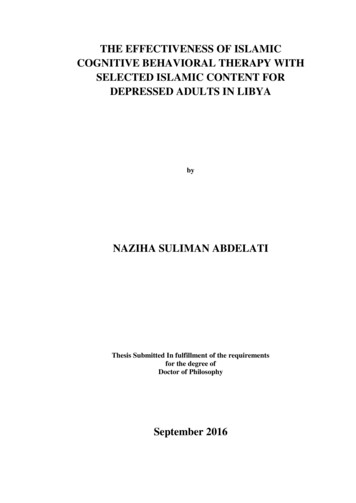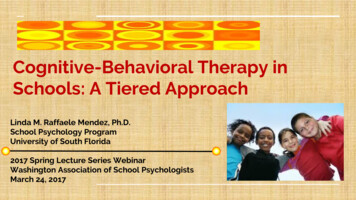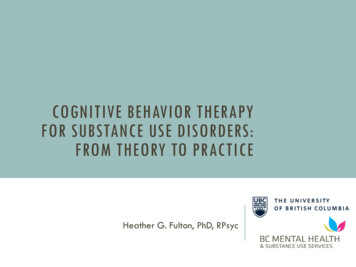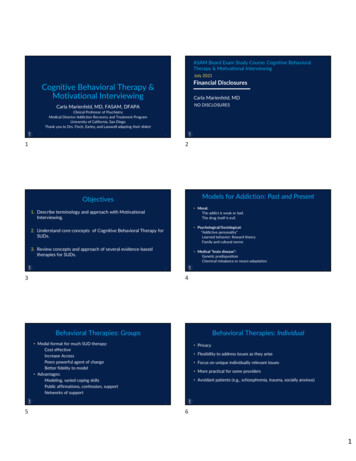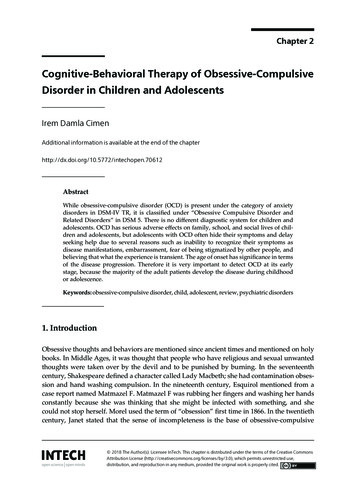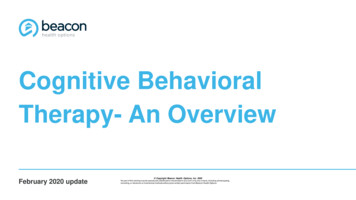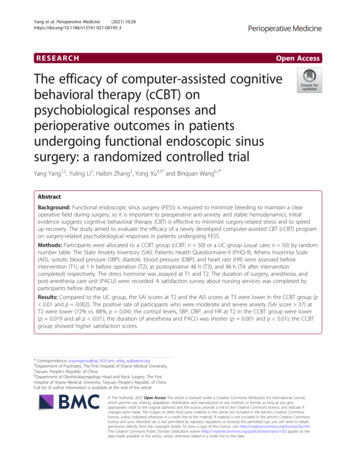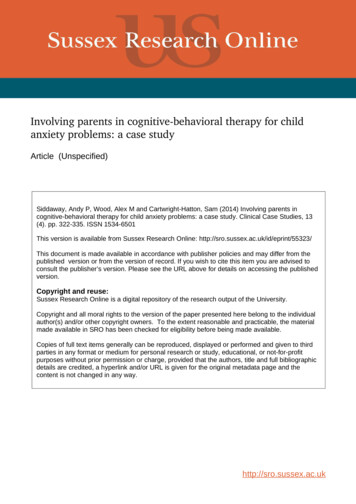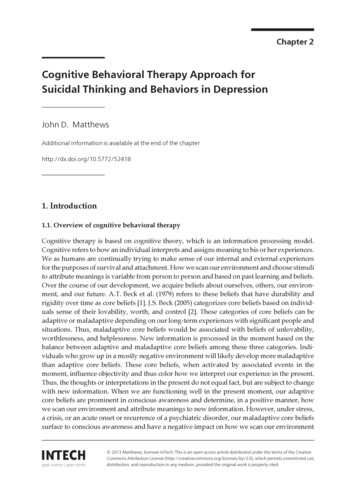
Transcription
Chapter 2Cognitive Behavioral Therapy Approach forSuicidal Thinking and Behaviors in DepressionJohn D. MatthewsAdditional information is available at the end of the chapterhttp://dx.doi.org/10.5772/524181. Introduction1.1. Overview of cognitive behavioral therapyCognitive therapy is based on cognitive theory, which is an information processing model.Cognitive refers to how an individual interprets and assigns meaning to his or her experiences.We as humans are continually trying to make sense of our internal and external experiencesfor the purposes of survival and attachment. How we scan our environment and choose stimulito attribute meanings is variable from person to person and based on past learning and beliefs.Over the course of our development, we acquire beliefs about ourselves, others, our environ‐ment, and our future. A.T. Beck et al. (1979) refers to these beliefs that have durability andrigidity over time as core beliefs [1]. J.S. Beck (2005) categorizes core beliefs based on individ‐uals sense of their lovability, worth, and control [2]. These categories of core beliefs can beadaptive or maladaptive depending on our long-term experiences with significant people andsituations. Thus, maladaptive core beliefs would be associated with beliefs of unlovability,worthlessness, and helplessness. New information is processed in the moment based on thebalance between adaptive and maladaptive core beliefs among these three categories. Indi‐viduals who grow up in a mostly negative environment will likely develop more maladaptivethan adaptive core beliefs. These core beliefs, when activated by associated events in themoment, influence objectivity and thus color how we interpret our experience in the present.Thus, the thoughts or interpretations in the present do not equal fact, but are subject to changewith new information. When we are functioning well in the present moment, our adaptivecore beliefs are prominent in conscious awareness and determine, in a positive manner, howwe scan our environment and attribute meanings to new information. However, under stress,a crisis, or an acute onset or recurrence of a psychiatric disorder, our maladaptive core beliefssurface to conscious awareness and have a negative impact on how we scan our environment 2013 Matthews; licensee InTech. This is an open access article distributed under the terms of the CreativeCommons Attribution License (http://creativecommons.org/licenses/by/3.0), which permits unrestricted use,distribution, and reproduction in any medium, provided the original work is properly cited.
24Mental Disorders - Theoretical and Empirical Perspectivesand process new information. When activated, maladaptive core beliefs mold new informationto fit the current maladaptive core belief, thus making it stronger. Persistent maladaptive corebeliefs are the basis, in part, of most psychopathology; however, CBT acknowledges the impactof biological and genetic factors, particularly in the case of major mental illnesses.Cognitive theory teaches that our emotions, physiological responses, and behaviors are aproduct of our thinking in the present moment. The spontaneous, unpremeditated interpre‐tations associated with specific events in the present are referred to as automatic thoughts [1].When the automatic thoughts are misinterpretations of current events, Beck refers to then asdysfunctional automatic thoughts [1]. If in a given situation an individual has the dysfunctionalautomatic thought, “I’m a loser”, this interpretation is likely due to the activation of themaladaptive core belief “I’m incompetent”. The products of the dysfunctional automaticthought, “I’m a loser”, might include sadness, anxiety, increased autonomic system activity,and a desire to avoid people. Cognitive theory also teaches that our emotions, physiologicalresponses, and behavior influence our thinking and beliefs as well. Studies have shown thatpeople who are depressed have difficulty accessing positive memories of past experiences andpast successes [3,4]. Because depressed patients tend to withdraw and isolate, they missopportunities to obtain information that might provide a more balanced view of themselves.Thus, there are multiple interactions among thoughts, feelings, physiological reactions, andbehaviors as shown in Figure 1.Figure 1.
A Cognitive Behavioral Therapy Approach for Suicidal Thinking and Behaviors in Depressionhttp://dx.doi.org/10.5772/52418The function of cognitive therapy is to reduce negative emotional reactions, distressingphysiological responses, and self-defeating behaviors by modifying dysfunctional automaticthoughts, initially, followed by modifying maladaptive core beliefs. Dysfunctional automaticthoughts are challenged by having the patient look for evidence against the negative thoughtsand/or by having the patient identify alternative explanations in a given situation. Maladaptivecore beliefs are modified through a process called “belief work” [5], which will be reviewedlater in the chapter. The underlying maladaptive core beliefs are revealed by observingpatterns of dysfunctional automatic thoughts across multiple situations in the present.Although the primary focus of CBT is on targeting dysfunctional automatic thoughts andmaladaptive core beliefs, negative emotions, distressing physiological responses, and selfdefeating behaviors also become targets for treatment. In the case of a depressed patient, whowas avoiding others out of fear of being criticized, behavioral activation strategies enabledhim to discover that there were several supportive people available to him, which resulted ina marked decrease in his fear and anxiety. Thus, the behavioral intervention had a positiveimpact on both his negative thinking and negative emotions. According to A.T. Beck et al.(1979), in order to achieve lasting change of our emotional distress and self-defeating behav‐iors, cognitive and behavioral interventions are required to change the underlying maladap‐tive core beliefs [1].In addition to dysfunctional automatic thoughts and maladaptive core beliefs, there are twoother problematic aspects of cognition, maladaptive intermediate beliefs and errors in logic [5].In view of the fact that awareness of one’s maladaptive core beliefs creates emotional distress,the individual develops and implements cognitive compensatory strategies or maladaptiveintermediate beliefs in order to prevent maladaptive core beliefs from being activated.Maladaptive intermediate beliefs consist of rules or assumptions that guide interactions withothers and one’s environment. These rules or assumptions take on a form of “if then ”statements that take on either a positive or negative valence. For example, a patient with a corebelief, “I am incompetent” may develop a maladaptive intermediate belief, “If I avoid makingmistakes, my weaknesses will not be seen by others” (positive form). Alternatively, “If I donot perform perfectly, I will fail” (negative form). In stressful situations, the negative formsare more prominent [5]. From a treatment perspective, it is important to identify a patient’smaladaptive intermediate beliefs since they contribute to his or her self-defeating behaviors.Frequently, there are corresponding maladaptive behaviors associated with maladaptiveintermediate beliefs. J.S. Beck (2011) refers to these behaviors as compensatory strategies [5].Like maladaptive intermediate beliefs, compensatory strategies serve the function of prevent‐ing maladaptive core beliefs from being activated. In the above example, “If I avoid makingmistakes, my weaknesses will not be seen by others”, a typical behavioral compensatorystrategy might be perfectionism. A patient would try to do his or her work perfectly in or toavoid the activation of his or her core belief “I’m incompetent”. Although performing perfectlyhas value in many situations, when perfectionism becomes a way of life, it can limit one’sexperience and interfere with achieving value-based goals. Errors in logic are the finalproblematic aspects of cognition to be addressed. The most common errors in logic include:mind reading (assumption that others are reacting negatively without sufficient evidence);overgeneralization (specific events defines life in general); all-or-nothing thinking (events are25
26Mental Disorders - Theoretical and Empirical Perspectivesseen in one of two mutually exclusive extreme categories); personalization (assuming respon‐sibility for negative outcomes without considering other contributing factors); and catastroph‐ic thinking (experiences or events are interpreted in terms of the worst possible outcomes).Errors in logic also contribute to faulty information processing and thus lead to misinterpre‐tations of events and experiences in the present.Figure 2.Figure 2 summarizes what has been reviewed thus far. Cognitive therapy begins by helpingpatients see the relationships among thoughts, feelings, physiological responses, and behav‐iors in a variety of situations in the present (illustrated in white). As patterns of interpretationsemerge, the therapist and patient develop a case formulation with the goal of identifying corebeliefs, intermediate beliefs, and compensatory strategies based on an analysis of the inter‐pretations from multiple situations in present, and based on a review of probable contributingnegative experiences from the past (illustrated in yellow). Once the individual’s core belief/sare identified, the focus of therapy is on modifying the underlying maladaptive core beliefs.J.S. Beck (2011) describes this process as “Belief Work” [5]. In the case of a patient with a corebelief, “I’m a failure”, the therapist would first have the patient reframe the maladaptive beliefin less severe terms, “Having weaknesses does not mean I’m a total failure”. The therapist nexthas the patient identify evidence against the maladaptive or old belief and supports the new
A Cognitive Behavioral Therapy Approach for Suicidal Thinking and Behaviors in Depressionhttp://dx.doi.org/10.5772/52418belief, “My evaluations at work are good, but not perfect”. Finally, the therapist has the patientidentify evidence that supports the old belief, but with a reframe, “Although I have deficien‐cies, I am more than my weaknesses.” To further enhance perspective building with regardsto maladaptive core beliefs, the therapist has the patient perform a historical review in orderto identify important events in his or her life that might have contributed to the developmentof the maladaptive core belief. The therapist then has the patient focus on specific relevantevents and generate alternative explanations by taking on an observer role using cognitiverestructuring (identifying evidence for and against the belief); in addition, the therapist assiststhe patient in collateral data collection by designing behavioral experiments [5].2. Cognitive factors for suicidal thinking and behaviorsThere are a number of cognitive factors that contribute to suicidal thinking and behaviors.These factors can be categorized as cognitive content deficits and cognitive informationprocessing deficits.2.1. Cognitive content deficitsBeck’s cognitive triad: A. T. Beck’s cognitive triad forms the foundation of the CBT model forsuicidal thinking and behaviors. According to A.T. Beck, depressed suicidal patients viewthemselves as defective, inadequate, diseased, or deprived and thus worthless and undesira‐ble; they view others as rejecting and unsupportive by making too many demands; and theyview their future as hopeless since they do not believe that they have the internal and externalresources to solve their problems [1].Their sense of defectiveness contributes to a passiveapproach to solving the problems that are creating their distress; they avoid making attemptsat solving their problem/s and they may even hope for a spontaneous solution [6]. Becausethey believe that no one really cares about them and because their problem/s seem over‐whelming to manage on their own, they give up. Without the personal skills and the supportof others, they conclude that there can be no future.Hopelessness: Hopelessness is a primary contributing factor in the development of suicidalthinking and behaviors and distinguishes depressed suicidal patients from depressed nonsuicidal patients [7]. Hopeless is the consequence of seeing no solutions to problems and theactivation of beliefs related to negative expectations: “I can never be happy”; “I am a burden tomy family and they will be better without me”. Hopelessness is more strongly related to suicideintent than depression or severity of symptoms [1,8]. More recent studies have demonstratedthat hopelessness can be measured reliably and that it is a mediator between depressionseverity and suicidal thinking and behaviors [9]. Thus, hopelessness predicts current andfuture suicidal thinking and behaviors. Researchers have distinguished between state and traithopelessness. State hopelessness is associated with the acute act of suicide; whereas, traithopelessness is associated with long-term negative expectations for the future. A. T. Beck(1986) argues that with strong trait hopelessness, it takes less stress to trigger a suicidal crisisand state hopelessness [10]. Young et al. (1996) found that persistent levels of hopelessness, in27
28Mental Disorders - Theoretical and Empirical Perspectivesdepressed patients who had achieved remission, was more predictive of suicide attempts thanhigh levels of hopelessness at a given time [11].Psychological/Physical Pain: Shneidman was among the first to stress the importance of theexperience of pain in contributing to suicidal thinking and behaviors. He referred to the painof the suicidal patient as psychache and he strongly believed that psychache was the driving forcefor a patient attempting suicide. “Psychache is at the dark heart of suicide; no psychache, nosuicide” (p.200) [12]. Chiles and Strosahl (2005) note that in a suicidal crisis, it is likely that anindividual will experience emotional or physical pain that he or she believes is “Intolerable”,“Inescapable”, “Interminable” [13]. According to Chiles and Strosahl, pain is viewed asintolerable if it exceeds one’s defined threshold; pain is viewed as inescapable if one does notsee any solutions to the problem causing the pain; and pain is viewed as interminable if onebelieves that it will never change on its own accord. The authors also stress that much of thedistress associated with pain is due to one’s relationship to his or her pain. A patient gets intoa struggle with his or her pain by resisting it and refusing to accept it in the context of therebeing no immediate solutions. Acceptance does not mean that a patient is giving-in, givingup, or has to be satisfied with his or her situation. Acceptance reduces the distress of wantingto be elsewhere then where one is, thus putting him or her in a better attitude or frame of mindto work on the problem that is responsible for his or her pain.2.2. Cognitive information processing deficitsCognitive rigidity and dichotomous: Cognitive rigidity and dichotomous thinking areconstructs that were proposed by Shneidman (1959) [14] and validated through research byNeuringer [15,16]. Cognitive rigidity refers to the inability to see options or alternative coursesof actions in problematic situations; in addition, a patient also fails to anticipate the array ofpossible consequences. Dichotomous thinking (“all-or-nothing thinking”) categorizes experi‐ences into one of two extremes, “good/bad’’ or “success/failure”. Thus a patient experiencesdifficulty in acknowledging nuances and subtleties in problem situations. These two cognitiveprocesses contribute to the problem solving deficits seen in a depressed suicidal patient [17].The steps to effective problem solving include: identify the possible solutions; review the prosand cons of each possible solution; choose the best solution from the pros and cons analysis;plan the implementation of the best solution; implement the plan; and evaluate the effective‐ness of the plan [18, 19]. Problem solving deficits are a function of cognitive rigidity anddichotomous thinking. Cognitive rigidity contributes to a decreased ability to generate newideas and anticipate various course outcomes; whereas, dichotomous thinking contributes toa tendency to focus on the negative consequences of potential courses of action.Attentional bias: As previously discussed, cognitive theory teaches that an individualselectively scans his or her environment, makes interpretations of his or her observations, andrecalls relevant information from the past in the process of trying to make sense of his or herinternal experiences. The processes of selection and interpretation are determined by pastexperiences, memories, and beliefs. Suicidal patients will automatically focus and selectinformation that is suicide-related, thus narrowing their perspective and awareness of othercourses of action than suicide. Studies supporting this concept have shown that patients who
A Cognitive Behavioral Therapy Approach for Suicidal Thinking and Behaviors in Depressionhttp://dx.doi.org/10.5772/52418have attempted suicide show an attentional bias towards words that are related to suicide onthe Emotional Stroop Task compared to negative or neutral words [20, 21].Attentional fixation: Wenzel et al. (2009) note that in suicidal patients that they have studied,patients report a mental state of confusion and disorientation immediately prior to their suicideattempt [22]. They are experiencing racing thoughts, agitation, “tunnel vision” as well as deepemotional pain. Suicide seems to be the only way out of their distress. Wenzel et al. (2009)compare this state of mind to what patients with panic disorder experience during a panicattack. Beck (1988) describes a “dissociation of higher-level reflective processes from automaticcognitive processing” [23]. Wenzel et al. (2009) believe that there is a similar process inoperation just prior to a suicide attempt [22]. Higher-level processing is unavailable to broadenawareness and to assist in identifying options that could lead to solving those problems thatare creating deep emotional pain. Attentional fixation interferes with rational informationprocessing and makes it difficult to disengage from suicide-related information, thus inter‐fering with problem solving and increasing as sense of hopelessness.Overgeneralized memory: Overgeneralized memory is another information processing defectobserved in depressed suicidal patients [24]. Studies have demonstrated that when patientswho have made recent suicide attempts are cued to provide details about a past personalexperience, they respond with vague recollections that summarize multiple experiences; theseresults were independent of processing speed [25, 21]. This finding is also seen when suicidalpatients were provided further prompts, explanations, and practice items in an attempt to helpclarify their responses [26]. This type of information processing interferes with effectiveproblem solving, which relies on the recall of details from past problem solving successes.3. A CBT model of suicideFigure 3 summarizes the research that has been presented in the previous paragraphs. Thismodel emphasizes that an individual considers suicide if he or she sees no solutions to theproblem that is creating pain that is perceived as intolerable, inescapable, and interminable.Thus, the focus of CBT in the depressed suicidal patient is to: identify the perceived unsolvableproblem; reduce cognitive distortions and errors in logic with regards to his or her views ofself, others, and future; improve problem solving skills; increase motivation to problem solve;reduce perceived emotional pain; and encourage acceptance of emotional pain as part ofeveryday life.4. AssessmentThere are a number of predictors of suicidal thinking and behaviors that have been identi‐fied over the years including being elderly, male, divorced, widowed, separated, medicallyill in the past 6 months, depressed, addicted to substances, and having made suicide at‐tempts in the past to name a few [27]. However, from a CBT perspective, it is not solely the29
30Mental Disorders - Theoretical and Empirical Perspectivessituation that determines suicidal thinking and behaviors, but, the meaning that an individ‐ual attributes to his or her situation. This is not to say that the above predictors do not havesome contribution to an individual’s decision to attempt suicide; rather, these predictorsmight indirectly contribute by increasing the individual’s vulnerability to choose suicide.Figure 3.4.1. Rating scalesBeck Hopelessness Scale (BHS) [8]: The Beck Hopelessness Scale is a twenty item, selfadministered, true false questionnaire developed to assess the degree of positive and negativebeliefs about the future during the previous week. It can be used in inpatient and outpatientsettings and for both adults and adolescence. The score ranges from 0 to 20; patients who scoreabove 8 are 11 times more likely to commit suicide than patients who score 8 or below [28]. Ina study to predict suicide over a 10-year period in outpatients with mixed diagnoses (N 1,958),while using a total score of 9, Beck et al. (1990) found a false-positive rate of 59% (those witha score of 9 and who did not commit suicide) and a false-negative rate of 5.9% (those with ascore of 9, but committed suicide) [29]. The test is an indirect indicator of suicide risk indepressed patients who have made suicide attempts and it is also useful for detecting hope‐lessness severity.
A Cognitive Behavioral Therapy Approach for Suicidal Thinking and Behaviors in Depressionhttp://dx.doi.org/10.5772/52418Beck Scale for Suicidal Ideation (BSS) [30]: The Beck Scale for Suicidal Ideation measures theintensity, pervasiveness, and characteristics of suicidal ideations in adults and adolescenceand has been used in a variety settings including, inpatient, outpatient, emergency services,and medical services [30]. An earlier self-administered version, the Scale for Suicidal Ideation(SSI) used the same questions, but is no longer in print. The BSS is a 21-item, self-administeredquestionnaire that asks questions regarding suicidal ideations over the past week. It is scoredon a 3-point Likert scale from 0 not present to 2 maximum severity of suicidal ideation. Ifitems 4 (“Desire to make active suicide attempt”) and 5 (“Passive suicidal desire”) are rated asa 1 (weak) or 2 (moderate to strong), the patient rates the rest of the items. The severity of thesuicidal ideations are calculated from the first 19-items and the range of scores is from 0-38.There is no cut-off score, but the severity of suicidal ideations are determined by increasingscores. Items on the scale can be re-examined over time in order to monitor for changes in therisk for suicide. The scale does not predict since there are no studies demonstrating that higherscores on the BSS predict immediate risk for a suicide attempt. Although most individuals whohave suicidal ideations do not attempt suicide, high scores on the BSS can alert clinicians toperform a more comprehensive assessment of suicide risk.Beck Suicide Intent Scale (SIS) is a clinician-administered measure of the intensity of thesuicide attempter’s desire to die at the time of the attempt [31, 32]. The scale consists of 20 itemson a 0-2 Likert scale for each item. Items 1-8 focus on preparation and manner of execution ofthe attempt, the setting, likelihood of rescue. Items 9-15 focus on the attempter’s perception ofthe lethality of the attempt, expectations of rescue, degree of premeditation, and the purposeof the attempt. Items 16-20 include the attempter’s reaction to the attempt, number of previousattempts, and the use of substances at the time of the attempt; items 16-20 are not included inthe total score. Studies have shown that items 1-8 distinguished fatal from non-fatal attempts.The total score differentiates repeat attempters from non-repeaters. One study found that the“Precautions against Discovery and/or Intervention was associated with increased risk ofeventual suicide [28]. However, there is no data to suggest that the SIS can be used to predictsuicide.Columbia-Suicide Severity Rating Scale (CSSRS) The Columbia-Suicide Severity RatingScale was developed as a single measure to assess severity of suicidal ideation and behaviorand to track them as well. The CSSRS was designed to distinguish suicidal ideation and behav‐ior. In the past, suicidal ideation and behavior were considered to be on a continuum [33]. Thescale is divided into four subscales: severity subscale; intensity subscale; behavior subscale;and the lethality subscale. The severity subscale measure severity of suicidal ideations on a 5point ordinal scale where 1 wish to be dead, 2 nonspecific active suicidal thoughts, 3 suicidalthoughts with methods, 4 suicidal intent, and 5 suicidal intent and plan. The intensity sub‐scale consists of 5 items, each rated on a 5-point ordinal scale with measures on frequency, du‐ration, controllability, deterrents, and reasons for ideations. The behavior subscale is rated on anominal scale that includes actual, aborted, and interrupted suicide attempts as well as meas‐ures on preparatory behavior and non-suicidal self-injurious behavior. The lethality subscale,which assess actual attempts, is rated on a 6-point ordinal scale; an actual attempt is given ascore of 0 and potential lethality of attempts is rated on a 3-point ordinal scale. The CSSRS uses31
32Mental Disorders - Theoretical and Empirical Perspectivesdifferent life-time assessment periods and studies have shown that the “worst-point ideation”was a stronger predictor of subsequent suicide than current ideation [34,35]. The inclusion ofall of the items in the scale were based on previous research that demonstrated that these meas‐ures predicted risk for future suicidal behaviors. In a recent study, Posner et al. (2011) demon‐strated that the CSSRS has good convergent and divergent validity with other suicidal ideationand behavior scales (e.g. Scale for Suicidal Ideation, Beck’s Lethality Scale, Beck Depression In‐ventory, Columbia Suicide History Form) and high sensitivity and specificity for suicidal be‐havior compared to another behavior scale [33]. In addition, they found that the ideation andbehavior subscales were sensitive to change over time.4.2. Motivation for suicideIdentifying the motive for suicide is crucial for determining the treatment approach. There aretwo primary motives for suicide, to escape from life with its pain or to produce some inter‐personal change or change in their environment [36]. In a study of 200 inpatients who hadmade a suicide attempt prior to admission, Kovacs, et al. (1975) found that 111 (56%) reportedescape as their primary motive, whereas, 26 (13%) reported hope to effect a change in othersor in their environment [36]. The reminder reported motives that were a combination of thetwo. The motive to escape was associated with more serious suicide attempts. Escape from lifewith its pain may be based on reality (poverty, medical problems, social isolation, chronicillness); thus, the focus of treatment is on appropriate biopsychosocial interventions. However,the motivation to end one’s life may be based on distorted or pathological ways of viewingoneself, others, and the world, thus, the focus is directed on misperceptions and irrationalbelief systems. When the primary motivation is to create interpersonal or environmentalchange, the common reasons are for love and affection, revenge, or control. Under thesecircumstances, the focus of treatment is on improving social skills and learning more effectiveand adaptive ways of communicating.4.3. Triggers for suicideRudd et al. (2001) stress the importance of identifying triggers of suicidal thinking andbehaviors [6]. Triggers can be categorized as being internal and external experiences or themes.Internal triggers include thoughts, images, feelings and physical sensations. External triggersinclude people, places, circumstances, and situations. Thematic triggers include activation ofabandonment concerns or fears of rejection. Tools that can assist in identifying triggers includedysfunctional thought records and chain analyses. A dysfunctional thought record is dividedinto five columns including: situation, emotions, dysfunctional automatic thoughts, rationalresponse, and re-rating the belief in the original dysfunctional automatic thoughts. TheDysfunctional Thought Record provides a strategy to not only identify the trigger for thedecision to choose suicide, but it identifies the misinterpretations associated with the triggeras well. The sequential links in the Chain Analysis strategy include: vulnerabilities (depres‐sion, stress, substance use, medical illness, loss etc.) prompting event (the event outside ofthe person that was the “last straw”) linked thoughts and feelings suicide attempt review consequences of suicide attempt review alternatives to suicide attempt.
A Cognitive Behavioral Therapy Approach for Suicidal Thinking and Behaviors in Depressionhttp://dx.doi.org/10.5772/524185. TreatmentThe goals of treatment for the depressed suicidal patient include: address specific cognitivebiases and distortions; develop behavior skills (problem solving); acceptance and tolerance ofemotional pain; improve communication skills (social skills, assertiveness training, conflictresolution skills); reduce environmental stress; and develop supports [13,27].In order to engage a patient in the treatment of his or her suicidal thinking and behaviors, theclinician must convey an empathic approach. The patient enters therapy with concerns thathe or she will be perceived as being irrational, trying to get attention, not being taken seriously,or potentially being punishe
the patient in collateral data collection by designing behavioral experiments [5]. 2. Cognitive factors for suicidal thinking and behaviors There are a number of cognitive factors that contribute to suicidal thinking and behaviors. These factors can be categorized as cognitive content deficits and cognitive information processing deficits. 2.1.
